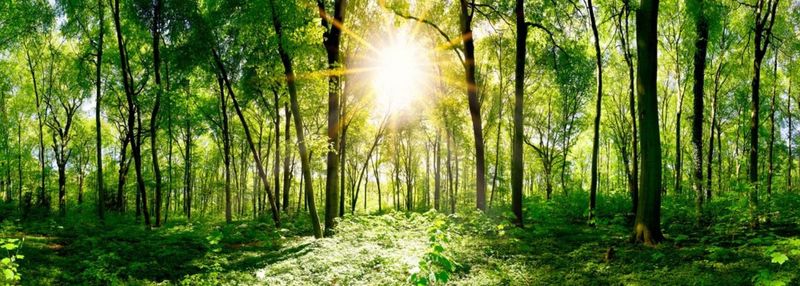Goals
- Understanding the basics of ecology, environmental factors and being able to define the concept of an ecological niche.
Ecology studies the interactions between organisms and their living and non-living environments, as well as the factors that influence the abundance and distribution of organisms.
The levels of ecological study range from looking at individual organisms to studying the function of the entire global ecosystem or biosphere.
The environmental factors that organisms use, such as food, water and light, are resources. These resources can be divided into living and non-living factors.
Living or biotic factors are related to other organisms in the community living in the same area. Biotic factors are individuals of the same or other species that influence the success of an organism. They can be food, predators, breeding partners, competing species, parasites or pathogens.

Non-living or abiotic factors relate to the properties of land, air and water. Abiotic factors can be divided into chemical and physical factors. Chemical environmental factors include rock types, soil pH, salinity and nutrient concentration. Physical environmental factors include things such as the amount and quality of light, variations in temperature and precipitation, and wind.

One of the most important abiotic factors is sunlight. Plants need sunlight for photosynthesis, together with water and carbon dioxide. During photosynthesis, plants produce a sugar called glucose, which they use to grow and reproduce.
The amount and quality of light can vary from region to region and from season to season. In Finland, for example, the amount of sunlight is lower than at the equator, while in summer it is available almost 24 hours a day.

The sun's heat radiation or infrared radiation is an important environmental factor for life on Earth.
Other important abiotic factors for plants include nutrients (e.g. nitrogen, phosphorus and potassium), the carbon dioxide needed for photosynthesis, the appropriate soil acidity (pH), oxygen and salinity.
Living (biotic) factors | |
food | The quantity and quality of nutrition affect the success of an individual. |
herbivores | Herbivores have a big influence on the success of plant species. |
competitors | Individuals of the same or another species may compete with each other, for example for food. |
predators, parasites and pathogens | No species can reproduce indefinitely even if food is plentiful, because at some point predators, parasites or pathogens will start to take their toll on the population. |
Non-living (abiotic) factors | |
sunlight | The amount of light (i.e. its intensity and duration) is an important factor for the success of plants. |
water | All living organisms need water. |
nutrients | Plants need elements such as nitrogen and phosphorus in order to grow. |
soil pH, wind | Many factors connected to climate and soil have a particular impact on plants and, through them, on animals. |
When you take into account the resources that the species needs, such as its nesting site and food, and other environmental factors that affect its success, such as predators, mates, diseases and temperature, they form a whole known as the species' ecological niche.
The ecological niche describes all the resources provided by nature that a species needs. The ecological niche expresses the species' interactions with the inanimate environment and other organisms through predation and competition.

There are different degrees of ecological niches. The basic ecological niche is the broadest and occurs in a situation where there is no competition. Competition reduces the basic niche to a realised niche. In a niche that is narrower than the specie's core niche, the population can no longer survive.
The relationship between two species (or their niches) can be described by looking at how much the two niches overlap. If two organisms share some of the same resources, they are in competition with each other for these resources. This leads to a shrinking of the ecological niches of the two organisms.
1. Mark the biotic factors that can affect the life of an individual.
2. Mark the abiotic factors that can affect the life of an individual.
1. Arrange the following things from the smallest (top) to the largest (bottom.)
2. Arrange the following things from the smallest (top) to the largest (bottom.)
1. Ecology is the study of the relationship between the environment and
2. A group of the same species living in a certain place make up
3. An organism’s role in its habitat is its
4. The ecological niche of a heron can include

Mitä haluat tehdä tekstillä? Teksti käsitellään tekälyn avulla, eikä sitä sen jälkeen muokata tai tarkisteta. Tekstissä voi esiintyä virheitä. Tarkista tekstin oikeellisuus vertaamalla sitä kirjan alkuperäistekstiin.
Valitse tiedostot, jotka haluat lisätä. Tuetut formaatit ovat txt, html, htm, pdf, odt, odp, ods, xls, xlsx, ppt, pptx, pps, doc, docx, rtf, png, jpg, jpeg ja gif.
| Nimi | |
|---|---|
| poista |
Huom.! Linkkien tulee alkaa ”http://”!
Opiq käyttää verkkosivun toiminnan, turvallisen käytön varmistamisen, käytön analysoimisen ja parhaan käyttömukavuuden tarjoamisen edellyttämiä evästeitä.
Eväste on käyttäjän tietokoneelta verkkosivun palvelimeen lähetettävä pieni tiedosto, joka sisältää verkkosivun toiminnan edellyttämiä käyttäjää ja hänen tekemiä valintoja koskevia tietoja.
Isoin osa evästeistä ovat Opiqin toiminnan kannalta välttämättömiä. Analyyttisistä evästeistä voi luopua ja silloin ei sinun käyttötietojasi ei käytetä Opiqin kehittämiseen. Lue lisää